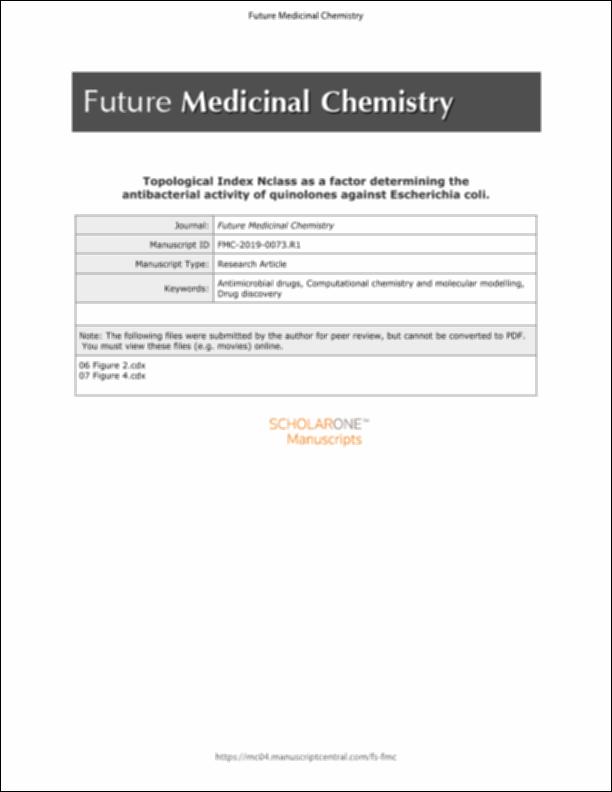Por favor, use este identificador para citar o enlazar este ítem:
http://hdl.handle.net/10637/11646Topological index Nclass as a factor determining the antibacterial activity of quinolones against Escherichia coli
| Título : | Topological index Nclass as a factor determining the antibacterial activity of quinolones against Escherichia coli |
| Autor : | Suay García, Beatriz Alemán López, Pedro Bueso Bordils, José Ignacio Falcó Montesinos, Antonio Pérez Gracia, María Teresa. Antón Fos, Gerardo Manuel |
| Materias: | Drug resistance in microorganisms - Mathematical models.; Pharmaceutical microbiology - Mathematical models.; Quinolonas - Modelos matemáticos.; Farmacología molecular - Modelos matemáticos.; Biología molecular - Modelos matemáticos.; Molecular biology - Mathematical models.; Escherichia coli - Resistencia a los medicamentos - Modelos matemáticos.; Escherichia coli - Drug resistance - Mathematical models.; Quinolone antibacterial agents - Mathematical models.; Bacterias - Resistencia a los medicamentos - Modelos matemáticos.; Molecular pharmacology - Mathematical models.; Microbiología farmacéutica - Modelos matemáticos. |
| Editorial : | Future Science. |
| Citación : | Suay García, B., Alemán-López , P., Bueso-Bordils, JI., Falcó, A., Pérez-Gracia, MT. & Antón-Fos, GM. (2019). Topological index Nclass as a factor determining the antibacterial activity of quinolones against Escherichia coli. Future Medicinal Chemistry, vol. 11, n. 17 (oct.), pp. 2255-2262 . DOI: https://doi.org/10.4155/fmc-2019-0073 |
| Resumen : | Background: Due to antibiotic resistance and the lack of investment in antimicrobial R&D, QSAR methods appear as an ideal approach for the discovery of new antibiotics. Result/Methodology: Molecular topology and LDA were used to construct a model to predict activity against Escherichia coli. This model establishes new SARs, of which, molecular size and complexity (Nclass), stand out for their discriminant power. This model was used for the virtual screening of the Index Merck database, with results showing a high success rate as well as a moderate restriction. Conclusions: The model efficiently finds new active compounds. The topological index Nclass can act as a filter in other QSAR models predicting activity against E. coli. |
| Descripción : | Este artículo se encuentra disponible en la página web de la revista en la siguiente URL: https://www.future-science.com/doi/10.4155/fmc-2019-0073 Este es el pre-print del siguiente artículo: Suay García, B., Alemán-López , P., Bueso-Bordils, JI., Falcó, A., Pérez-Gracia, MT. & Antón-Fos, GM. (2019). Topological index Nclass as a factor determining the antibacterial activity of quinolones against Escherichia coli. Future Medicinal Chemistry, vol. 11, n. 17 (oct.), pp. 2255-2262 que se ha publicado de forma definitiva en https://doi.org/10.4155/fmc-2019-0073 This is the pre-peer reviewed version of the following article: Suay García, B., Alemán-López , P., Bueso-Bordils, JI., Falcó, A., Pérez-Gracia, MT. & Antón-Fos, GM. (2019). Topological index Nclass as a factor determining the antibacterial activity of quinolones against Escherichia coli. Future Medicinal Chemistry, vol. 11, n. 17 (oct.), pp. 2255-2262, which has been published in final form at https://doi.org/10.4155/fmc-2019-0073 |
| URI : | http://hdl.handle.net/10637/11646 |
| Derechos: | http://creativecommons.org/licenses/by-nc-nd/4.0/deed.es |
| ISSN : | 1756-8919 1756-8927 (Electrónico) |
| Fecha de publicación : | 1-oct-2019 |
| Centro : | Universidad Cardenal Herrera-CEU |
| Aparece en las colecciones: | Dpto. Farmacia |
Los ítems de DSpace están protegidos por copyright, con todos los derechos reservados, a menos que se indique lo contrario.


